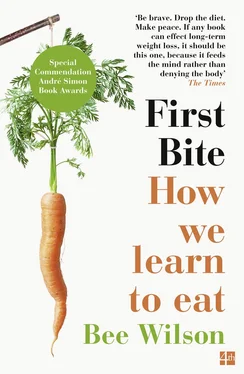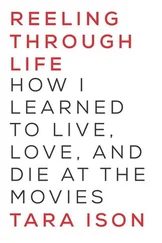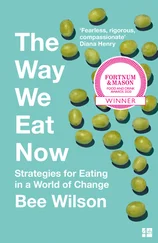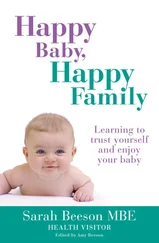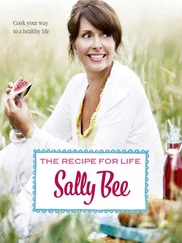The reason many find it hard to eat healthily is that we have never learned any differently. Like children, most of us eat what we like and we only like what we know. Never before have whole populations learned (or mislearned) to eat in societies where calorie-dense food was so abundant and policed with so few norms about portion sizes and mealtimes. Nor is overeating the only problem that plagues modern affluent civilizations. Statistics suggest that around 0.3 per cent of young women are anorexic and another 1 per cent are bulimic, with rising numbers of men joining them. 6What statistics are not particularly effective at telling us is how many others – whether overweight or underweight – are in a perpetual state of anxiety about what they consume, living in fear of carbs or fat grams and unable to derive straightforward enjoyment from meals. A 2003 study of 2,200 American college students suggested that weight concern is very common: 43 per cent of this sample were worried about their weight most of the time (across both sexes) and 29 per cent of the women described themselves as ‘obsessively preoccupied’ with weight. 7
Our dietary malaise is often discussed in fatalistic terms, as if our preference for hamburgers were a life sentence: diets don’t work, sugar is addictive and so on. What we forget is that, as omnivores, we are extremely gifted at changing the way we eat to accommodate different environments. Admittedly, no one has ever encountered a food environment quite like the one we now find ourselves in, flooded with cheap calories in deceptive packaging. To survive in our current situation will entail very different skills from those needed by a Palaeolithic hunter-gatherer. Yet there is every reason to suppose that we are capable of acquiring these skills, if we give ourselves half a chance.
If our food habits are learned, they can also be relearned. Imagine you were adopted at birth by parents who lived in a remote village in a far-flung country. Your tastes would be quite unlike the ones you ended up with. We all begin life with an innate liking for sweetness and a suspicion of bitterness, yet there is nothing inevitable in our physiology that says that we will grow up dreading vegetables and craving fudge. The trouble is, we do not tend to see it this way.
My premise in First Bite is that the question of how we learn to eat – both individually and collectively – is the key to how food, for so many people, has gone so badly wrong. The greatest public health problem of modern times is how to persuade people to make better food choices. But we have been looking for answers in the wrong places.
Our discussion about diet is usually framed in terms of better information. A sea of articles and books suggests that the reason for the obesity crisis is that we were given the wrong advice: we were told to avoid fat when the real demon was sugar. 8There’s something in this. It certainly didn’t help that many of the ‘low-fat’ products marketed as healthy over the past few decades were padded with refined carbohydrates and were therefore more fattening than the fats we were being advised to give up. 9During the period that dieticians were admonishing us to abstain from saturated fats such as those in butter, cream and meat, obesity rates were consistently going up, not down. It is becoming increasingly clear that eating fat is not in and of itself the thing that makes you fat or gives you heart disease.
Before we start blaming the confusing low-fat advice for our current ill health, however, it might be useful to consider the extent to which we ever followed those anti-fat warnings. The vast majority of people heard what the ‘food police’ had to say on the subject of fat and ignored it. At the height of the low-fat orthodoxy, in 1998, some of the leading nutrition scientists in the world co-authored a paper in which they lamented the public’s failure to follow their guidelines. The scientists found, to their dismay, that after more than two decades of being advised to reduce fat, people were still eating ‘about the same’ amount of it. The percentage of calories from fat in the American diet dropped slightly from 1976 to 1991 (from about 36 per cent in 1976 to 34 per cent in 1991) but this was only because people were consuming more total calories. In absolute terms, the fat grams people consumed on average remained the same. 10
David L. Katz of the Yale University Prevention Research Center is a rare voice of sanity in the clamorous world of nutrition. He disputes the commonly held view that the reason we don’t eat better is because there is so much confusion over what the ‘best diet’ really is. Katz points out that the essential tenets of a healthy life – moderate helpings of a variety of real whole foods, plus regular exercise – have been very well established for decades. The medical evidence suggests that it doesn’t matter whether we reach this point via a low-fat route or a low-carb one (or vegan or Paleo or just good old-fashioned home cooking). 11Across all diets, there is, notes Katz, a huge ‘aggregation of evidence’ that the best pattern of eating for health is a diet of minimally processed foods, mostly plant-based. ‘Our problem,’ notes Katz, ‘is not want of knowledge about the basic care and feeding of Homo Sapiens. Our problem is a stunning and tragically costly cultural reluctance – to swallow it.’ 12
Take vegetables. The advice to eat more vegetables for health could hardly have been clearer. We have been given the message many times, in many forms. Unlike with fat or sugar, there is no about-turn or controversy in mainstream nutrition over the ‘eat more vegetables’ message. Yet since the 1970s the total intake of calories from vegetables in America has actually declined by 3 per cent, which is a bigger drop than it sounds considering that vegetables contain very few calories compared to other foods. 13This decline came at a time when there has never been a wider variety of tempting vegetables available, from deep orange butternut squash to pale green Romanesco broccoli. Many people, however, have absorbed the lesson from childhood that vegetables and pleasure – and more generally, healthy food and pleasure – can never go together. Witness the waves of antipathy directed at public figures such as Michelle Obama when they dare to suggest that we eat more of them. Consumer scientists have found that when a new product is described as ‘healthy’, it is far less likely to be a success than if it is described as ‘new’. 14
When it comes to our dining habits, there is a giant mismatch between thought and deed; between knowledge and behaviour. ‘Eat food. Not too much. Mostly plants,’ says influential food writer Michael Pollan. 15A wise and simple mantra, much repeated; yet for many it seems anything but simple to follow in daily life. To adhere to it you need to: ‘Like real food. Not enjoy feeling overstuffed. And appreciate vegetables.’ These are skills that many people have not yet acquired, however intelligent or advanced in years they may be. There’s another complication, too. The ‘not too much’ part of Pollan’s dictum needs modifying to take account of those who have learned to eat too little , or at least not enough of the right foods. I am not just talking about the underweight. The term ‘malnutrition’ now covers obesity as well as starvation; there is evidence that obese populations across the world suffer disproportionately from micronutrient deficiencies, notably vitamins A and D, plus zinc and iron. 16Learning how to eat better is not about reducing consumption across the board. While we undoubtedly need to eat less of many foods – sugar springs to mind – we need more of others. Among other lost eating skills – see also not ‘spoiling your appetite’ and not ‘wolfing down your dinner’ – we seem to have lost the old-fashioned concept of ‘nourishing’ ourselves.
Читать дальше
